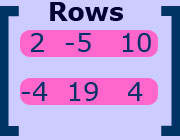Degrees
-0 degree-constant
-1st degree-linear
-2nd degree- quadratic ( U- shaped )
-3rd degree-cubic ( S- shaped )
-4th degree- quartic
-5th degree-quintic
The number of turns a polynomial has is always one less of their degree.
Terms
monomial- one term
binomial- two terms
trinomial- three terms
quadrinomial- four terms
polynomial- more than four terms
binomial- two terms
trinomial- three terms
quadrinomial- four terms
polynomial- more than four terms
Linear Equations
1st degree- 0 turns
y=mx+b
When the slope of a line is positive, then the line rises to the right and falls to the left.
When the slope of a line is negative, the the line rises to the left and falls to the right.
Quadratic Equations
2nd degree- 1 turn
y=ax²
(a+b)(c+d)
When a parabolic graph is positive, then it rises right and left.
When a parabolic equation is negative then it falls both and left and right.


















